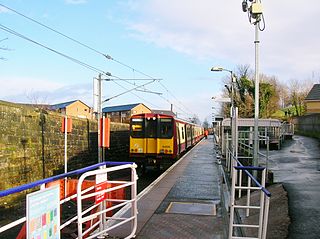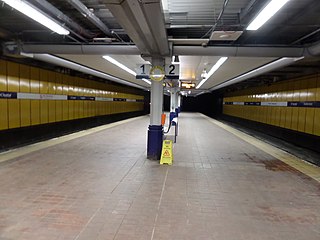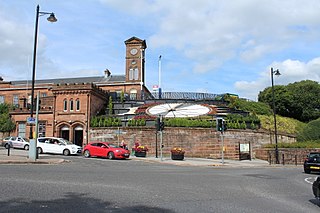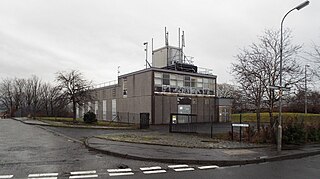
The Paisley Canal line is a branch railway line in Scotland running between Glasgow and Paisley. The line currently terminates at Paisley Canal railway station, although it previously continued through Paisley West station, near Ferguslie, to Elderslie junction where it met and crossed under the main Glasgow and South Western Railway line running from Paisley Gilmour Street station to Johnstone, and beyond. After Elderslie, the line terminated at North Johnstone, however another junction allowed services from the Paisley Canal line to continue onto the Bridge of Weir Railway and Greenock and Ayrshire Railway to the latter's terminus at Greenock Princes Pier.

Anderston railway station serves Glasgow's financial district of Anderston and, across the M8 motorway, the housing schemes of both Anderston West and the Blythswood Court estate of the Anderston Centre. It is also close to both the Hilton and Marriott hotels. It is a staffed station with an island platform and most of it is underground.

Pollokshaws East railway station is a railway station in Glasgow, Scotland, serving parts of the Pollokshaws, Auldhouse, Newlands and Shawlands neighbourhoods of the city. The station is managed by ScotRail and is located on the Cathcart Circle Line.

Barrhead railway station is a railway station in the town of Barrhead, East Renfrewshire, Greater Glasgow, Scotland. The station is managed by ScotRail and is on the Glasgow South Western Line, 7+1⁄2 miles (12.1 km) southwest of Glasgow Central.

Kilmarnock railway station is a railway station in Kilmarnock, East Ayrshire, Scotland. The station is managed by ScotRail and is served by trains on the Glasgow South Western Line. One of the earliest railway stations in Scotland, the Kilmarnock and Troon Railway opened on 6 July 1812, until it was replaced by the Glasgow, Paisley, Kilmarnock and Ayr Railway on 4 April 1843.
The City of Glasgow Union Railway - City Union Line, also known as the Tron Line, was a railway company founded in Glasgow, Scotland, in 1864 to build a line connecting the railway systems north and south of the River Clyde, and to build a central passenger terminus and a general goods depot for the city. The through line, running from south-west to north-east across the city, opened in 1870–71, and the passenger terminal was St Enoch railway station, opened in 1876. The railway bridge across the Clyde was the first in the city.
The Glasgow and Paisley Joint Railway was the section of railway line between Glasgow Bridge Street railway station and Paisley, in the west of Scotland. It was constructed and operated jointly by two competing railway companies as the stem of their lines to Greenock and Ayr respectively, and it opened in 1840. The Joint Committee, which controlled the line, built a branch to Govan and later to Cessnock Dock, and then Prince's Dock.
The Dalry and North Johnstone Line was a branch of the Glasgow and South Western Railway (G&SWR) in Renfrewshire and Ayrshire, Scotland, connecting the stations in Elderslie and Dalry via a route running parallel to the existing line built by the Glasgow, Paisley, Kilmarnock and Ayr Railway. This provided additional line capacity for Ayrshire Coast and Kilmarnock services. The loop line was used for passenger services until the mid-1960s, when it was closed by the Beeching Axe. The majority of the line's trackbed has since been absorbed into the Sustrans National Cycle Network.

Strathbungo railway station was a railway station serving the village of Strathbungo, Renfrewshire,, Scotland. The station was originally part of the Glasgow, Barrhead and Kilmarnock Joint Railway.

Kilmacolm railway station was a railway station serving the village of Kilmacolm, in the current council area of Inverclyde and the historic county of Renfrewshire in the West-Central Lowlands of Scotland. It was originally part of the Greenock and Ayrshire Railway, later a line of the Glasgow and South Western Railway.
The Glasgow and Renfrew District Railway was nominally owned by the Glasgow and Paisley Joint Railway. It was incorporated on 6 August 1897 and opened on 1 June 1903.
The Cathcart District Railway was proposed to serve the arising demand for suburban residential travel on the south side of Glasgow, Scotland. It was planned as a loop running to and from Glasgow Central station, but at first only the eastern arm, to Cathcart via Queens Park, was built, opening in 1886. The western arm was opened in 1894 and trains operated round the loop. A frequent passenger train service was operated, and there was also a limited goods and mineral operation.

Gorebridge is a railway station on the Borders Railway, which runs between Edinburgh Waverley and Tweedbank. The station, situated 11 miles 77 chains (19 km) south-east of Edinburgh Waverley, serves the town of Gorebridge in Midlothian, Scotland. It is owned by Network Rail and managed by ScotRail.
The Maybole and Girvan Junction Railway was a railway company that constructed a line between Maybole and Girvan. Although promoted independently, it was supported by the Glasgow and South Western Railway, and was seen as part of a trunk line connecting Glasgow with a ferry port for the north of Ireland.

Garlieston is the closed terminus of the Garlieston branch of Wigtownshire Railway; running from a junction at Millisle. It served the coastal village and harbour of Garlieston in Wigtownshire. The Garlieston branch, together with the rest of the Wigtownshire Railway, closed completely in 1964.
The Hamilton and Strathaven Railway was a historic railway in Scotland. It ran from a junction with the Hamilton Branch of the Caledonian Railway to a terminus at Strathaven. The railway was worked from the start by the Caledonian Railway, who absorbed the railway company in 1864.
Abington railway station was a station which served Abington, in the Scottish county of South Lanarkshire. It was served by local trains on what is now known as the West Coast Main Line. There is now no station convenient for Abington.

Greenock Princes Pier was a railway station serving Greenock, Renfrewshire, Scotland, originally as part of the Greenock and Ayrshire Railway. It was approached by a tunnel sloping downhill under Greenock's west end, with railway sidings before the line crossed Brougham Street bridge over the main road to Gourock. The station was set on an embankment on the approach to Prince's Pier, with a line curving down to serve Albert Harbour.

Greenock Lynedoch was a railway station serving Greenock, Inverclyde, Scotland, originally as part of the Greenock and Ayrshire Railway.

Port Glasgow Upper was a railway station serving Port Glasgow, Renfrewshire, Scotland, originally as part of the Greenock and Ayrshire Railway.















